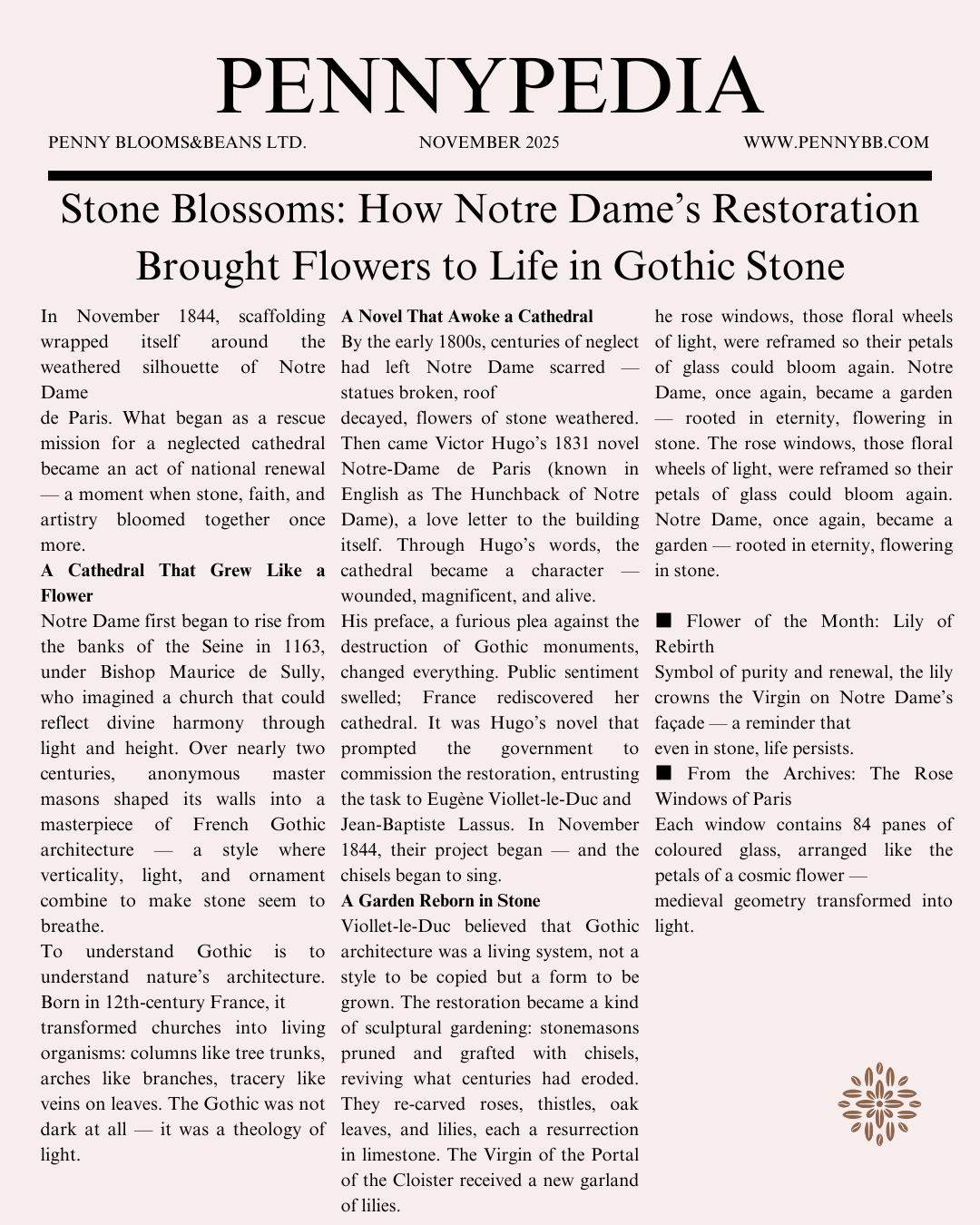
04 Nov Stone Blossoms

In November 1844, scaffolding wrapped itself around the weathered silhouette of Notre Dame de Paris. What began as a rescue mission for a neglected cathedral became an act of national renewal — a moment when stone, faith, and artistry bloomed together once more.
A Cathedral That Grew Like a Flower
Notre Dame first began to rise from the banks of the Seine in 1163, under Bishop Maurice de Sully, who imagined a church that could reflect divine harmony through light and height. Over nearly two centuries, anonymous master masons shaped its walls into a masterpiece of French Gothic architecture — a style where verticality, light, and ornament combine to make stone seem to breathe.
To understand Gothic is to understand nature’s architecture. Born in 12th-century France, it transformed churches into living organisms: columns like tree trunks, arches like branches, tracery like veins on leaves. The Gothic was not dark at all — it was a theology of light.
A Novel That Awoke a Cathedral
By the early 1800s, centuries of neglect had left Notre Dame scarred — statues broken, roof decayed, flowers of stone weathered. Then came Victor Hugo’s 1831 novel Notre-Dame de Paris (known in English as The Hunchback of Notre Dame), a love letter to the building itself.
Through Hugo’s words, the cathedral became a character — wounded, magnificent, and alive. His preface, a furious plea against the destruction of Gothic monuments, changed everything.
Public sentiment swelled; France rediscovered her cathedral. It was Hugo’s novel that prompted the government to commission the restoration, entrusting the task to Eugène Viollet-le-Duc and Jean-Baptiste Lassus. In November 1844, their project began — and the chisels began to sing.
A Garden Reborn in Stone
Viollet-le-Duc believed that Gothic architecture was a living system, not a style to be copied but a form to be grown. The restoration became a kind of sculptural gardening: stonemasons pruned and grafted with chisels, reviving what centuries had eroded. They re-carved roses, thistles, oak leaves, and lilies, each a resurrection in limestone. The Virgin of the Portal of the Cloister received a new garland of lilies. The rose windows, those floral wheels of light, were reframed so their petals of glass could bloom again. Notre Dame, once again, became a garden — rooted in eternity, flowering in stone.
Nature, Faith, and the Idea of Permanence
For Viollet-le-Duc and his Romantic contemporaries, Gothic was the perfect metaphor for faith and nature intertwined. Every curve and carving expressed divine logic, every leaf a reflection of creation’s order. November 1844 was not just the start of a restoration — it was the rebirth of a philosophy: that beauty, like nature, endures through renewal. The cathedral that once decayed under revolution now bloomed again in devotion and light.
A Flower’s Lesson in Resilience
After the 2019 fire, the same words returned. Conservators spoke of “saving the stone petals,” of “restoring the rose.” The metaphors were centuries old, yet timeless — because Notre Dame, like the flowers carved into its walls, survives by blooming again and again.
Each November, when Paris turns grey, the cathedral remembers its first winter of rebirth — when chisels hummed like bees, and stone began to blossom once more.
Flower of the Month: Lily of Rebirth
Symbol of purity and renewal, the lily crowns the Virgin on Notre Dame’s façade — a reminder that even in stone, life persists.
From the Archives: The Rose Windows of Paris
Each window contains 84 panes of coloured glass, arranged like the petals of a cosmic flower — medieval geometry transformed into light.
